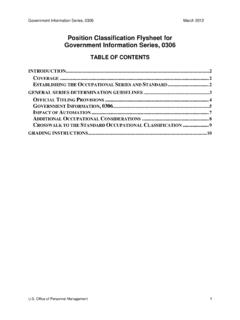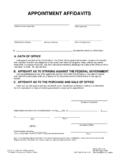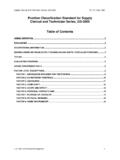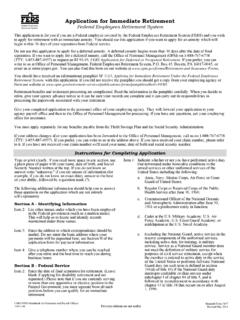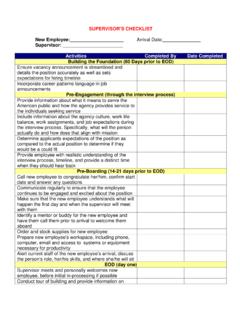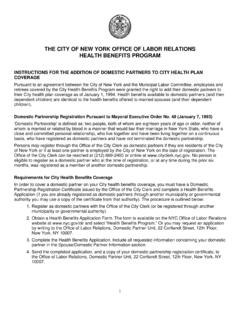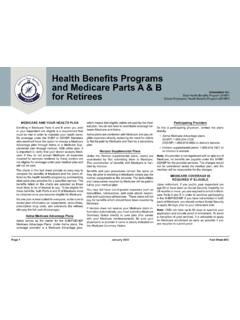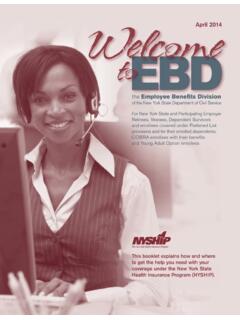Transcription of Information for Retirees and Survivor Annuitants
1 Information for Retirees and Survivor Annuitants Federal Employees health benefits (FEHB). This pamphlet contains Information about the Federal Employees health benefits Program. Refer to it when you or your family have questions about the program. We provide retirement Information and assistance on the Internet. You will find retirement brochures, forms, and other Information at: You will find health benefits plan brochures at: You may also contact us for assistance using email at: We will respond to your email address. Table of Contents Page Contacting the Office of Personnel Management ..1. health benefits Coverage ..2. If You Are a retiree ..2. Disabled Children Age 26 or Foster New Family If You Are a Widow(er) Survivor annuitant or Are Receiving the FERS Basic Employee Death Benefit ..4. If You Are a Former Spouse Survivor Deferred Annuitants ..5. Federal Employees Retirement System (FERS) Postponed When a Family Member Loses Eligibility for Coverage ..5. Changing Your FEHB Coverage.
2 6. Factors to Consider When Changing Your Plan ..6. Plans (called Medicare Advantage plans). Approved by The Centers for Medicare and Medicaid Services (CMS) ..7. If You Want to Suspend Your If You Want to Reactivate Suspended Coverage ..9. Medicaid and Your Federal Employees health benefits (FEHB) If You Want to Cancel Your enrollment ..10. Families Where Both Spouses Are Eligible Under the FEHB Program in Their Own Right ..10. Direct Payment of Premiums by How to Change Your Effective Dates for enrollment Events Which Permit Change ..14. Federal Employment and health benefits ..16. Continuation of Coverage for survivors After Enrollee's Death ..16. Widows, Widowers, and Former Spouses ..16. Continuation of Coverage for Children After the Death of the Parent Who Was Covering the Child ..17. i Widow(er) Survivor Annuitants Who Are Also Federal Employees ..18. Premium Conversion for Employees ..18. Reinstatement When Employment What Events Terminate health benefits Coverage ..19. If You Are a retiree .
3 19. If You Are a Reemployed annuitant ..20. If You Are a Widow or Widower Survivor If You Are a Former Spouse Survivor If You Are a Child Survivor Widow(er)'s Reenrollment in FEHB. If Remarriage If FEHB Coverage Ends ..23. 31-Day Extension of Coverage ..23. Conversion to a Nongroup Temporary Continuation of Federal Employees health benefits (FEHB). Coverage ..25. How Medicare Affects Your health benefits Medicare How to File Claims for Medical Expenses ..29. If Your Claim for Medical Expenses Is How to Obtain an FEHB. Identification Special Information for Compensationers ..32. Related Information and ii Contacting the Office of Personnel Management (OPM). You can call us about your health benefits enrollment . Our toll-free telephone number is 1-888-767-6738. This is an automated system that allows you to leave us a message any time. On regular business days you can speak to one of our Customer Service Specialists between the hours of 7:30 and 7:45 (Eastern time). Persons with hearing impairments who have TTY equipment should call 1-855-887-4957.
4 You may also contact us for assistance at We will make the following changes in your health benefits enrollment based on a telephone call: Change from family to self-only enrollment . Change plans when you have moved out of the service area of a health maintenance organization. Change from one plan or option to another because you are eligible for Medicare. Cancel or suspend your enrollment ; we will send you the form you need to use to confirm this in writing. If you prefer, you can write to us at: Office of Personnel Management Retirement Operations Center Box 45. Boyers, PA 16017-0045. Anytime you contact us, be sure to give us your retirement claim number (CSA number) or Survivor annuity number (CSF number). This number is on all correspondence from us. Also, give us your date of birth and be sure to sign and date your correspondence. If you are a Survivor annuitant or if you are a widow(er) of a deceased employee paying premiums directly to us, provide the name of the former Federal employee on whose service your annuity is based, as well as your CSF number.
5 1. health benefits Coverage There are two types of enrollment in the Federal Employees health benefits (FEHB) Program: 1. Self Only - This enrollment provides benefits only for you. 2. Self and Family - This enrollment provides benefits for you and for all eligible family members. If You Are a retiree A Self and Family enrollment covers you, your spouse, and your children under age 26 (see below for Information on disabled children), including your legally adopted children and recognized natural children. Your foster children can also be included if you certify that they live with you in a regular parent-child relationship and meet all the requirements on the certification. If you need to include a foster child, contact OPM to obtain the certification form. Other relatives, such as parents or a grandchild (unless the grandchild qualifies as a foster child), are not eligible for coverage as family members even if they live with and are dependent on you. Your monthly premium for a Self and Family enrollment is the same amount regardless of the number of family members covered by the enrollment .
6 If a family member loses eligibility for coverage, your premium is not reduced. However, if you become the only person eligible for coverage, you should contact us. We will change your enrollment to the less expensive Self Only coverage. Note: A family member or friend must contact OPM. immediately in the event of your death. 2. Disabled Children Age 26 or Older A child incapable of self-support because of a disability which began before his/her 26th birthday and which is expected to last more than one year may continue to be covered as a family member after reaching age 26. If you have already established a child's eligibility for continued coverage with your former employing office and they have forwarded this documentation to us, you need take no further action unless we ask for another medical certificate. If you have a child who is disabled but have not yet established that fact, contact us. We will send you a form which you and the child's doctor must complete. Foster Children A foster child for health benefits purposes is a child under age 26 who: is financially dependent on you, and lives with you in a regular parent-child relationship.
7 There must be an expectation you will continue to raise the child into adulthood. You must certify this as discussed on page 2. A grandchild who meets these criteria may be covered as a foster child. A. child temporarily living with you is not a foster child;. neither is one placed in your home by a welfare or social service agency which retains control of the child and pays for maintenance. New Family Members If you have a Self and Family enrollment , any new eligible family member such as a new spouse, if you are a retired employee is automatically covered by your health plan. Please notify your health insurance carrier about your new family member so they can update their records. Your carrier may ask for proof of your relationship (such as proof of marriage or birth) and for the new family member's name, date of birth, and Social Security Number. If you are enrolled for Self Only and acquire a new family member, you may change to a 3. Self and Family enrollment as shown on pages 14.
8 And 15. If You Are a Widow(er) Survivor annuitant or Are Receiving the FERS. Basic Employee Death Benefit A Self and Family enrollment provides coverage for you and all eligible family members of the deceased employee or retiree , as described above. If you remarry before age 55, your coverage will end. See page 22 for Information about reenrollment. However, if your Survivor annuity continues because you were married to the deceased for 30 years or more, your coverage will continue, but it will not cover your new spouse and his or her dependents. If you remarry at or after age 55, your coverage will continue, but it will not cover your new spouse and his or her dependents. If you also receive an annuity as a retiree based on your own Federal career, you may be eligible to transfer the enrollment to your retirement annuity to cover your new spouse and his or her eligible children. If you wish to do so, contact us. Be sure to provide your retirement and Survivor annuity claim numbers. We will determine if you are eligible to transfer your enrollment after we receive your request.
9 If You Are a Former Spouse Survivor annuitant If you have health benefits coverage as a former spouse ( , your marriage terminated before the employee's or retiree 's death), a Self and Family enrollment covers you and any natural child or adopted child under age 26 from your marriage to the employee or retiree . A disabled child age 26 or older may also be covered. You cannot cover any foster child or grandchild. If you remarry, your new spouse and his or her children cannot be included in your enrollment . If you remarry before age 55, your enrollment will end, even though your Survivor 4. annuity continues because you were married to the deceased for 30 years or more. Deferred Annuitants If you separated from Federal service before you could retire and are now receiving a deferred annuity that started when you were 62, you are not eligible to enroll in the Federal Employees health benefits Program. You may have coverage under the program as a family member based on your spouse's enrollment , but not based on your deferred annuity.
10 Federal Employees Retirement System (FERS) Postponed Retirement If you are covered by FERS and eligible for an immediate retirement at separation from government service, you may postpone receiving your annuity to avoid the age reduction. You are eligible to reenroll for health benefits and life insurance coverage when you begin to receive your postponed annuity, if you were eligible to continue the coverage in retirement. When a Family Member Loses Eligibility for Coverage You will not be informed by us or by your health insurance carrier when a family member loses eligibility for coverage. Your spouse loses eligibility for coverage under your Self and Family enrollment on the effective date of divorce or annulment of the marriage. 5. A child loses eligibility for coverage upon the date of attainment of age 26. A disabled child age 26 or older loses eligibility for coverage upon recovery of ability for self support. If your family member loses eligibility for coverage for any of the above reasons, you may ask us for Information about temporary continuation of coverage; this is discussed on page 25.


